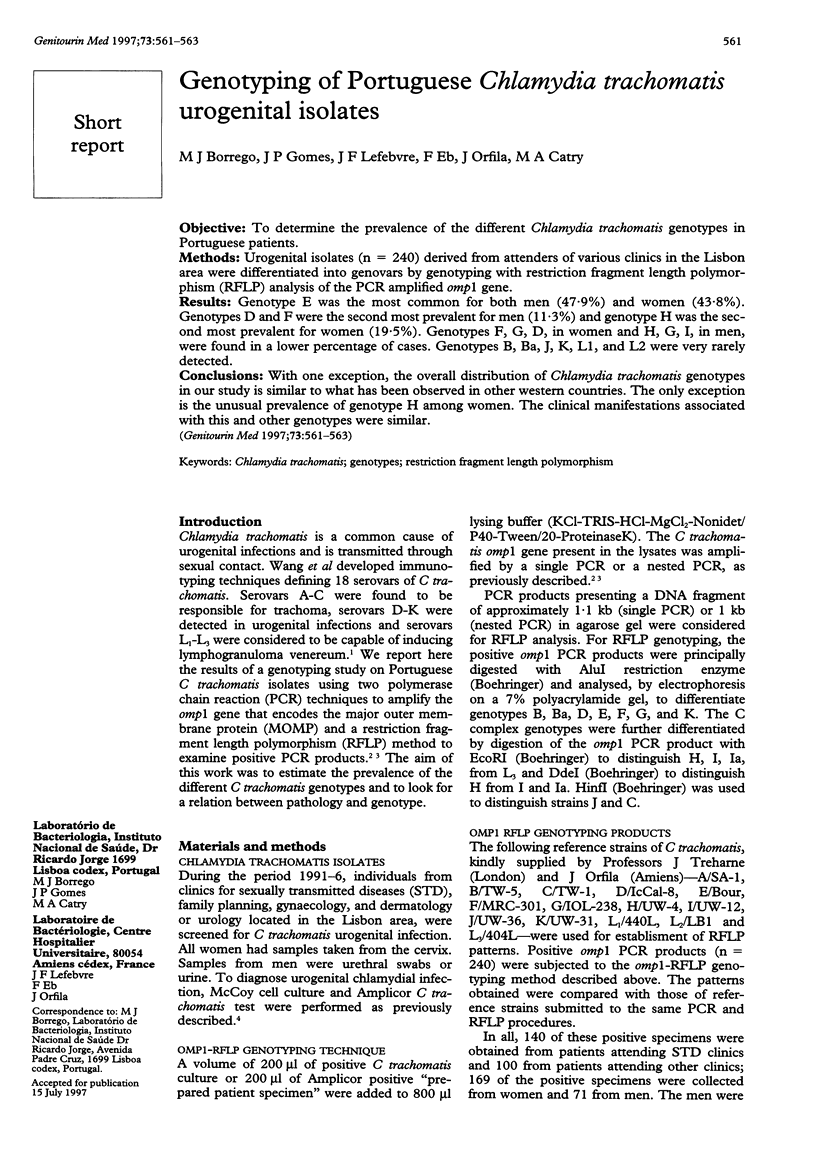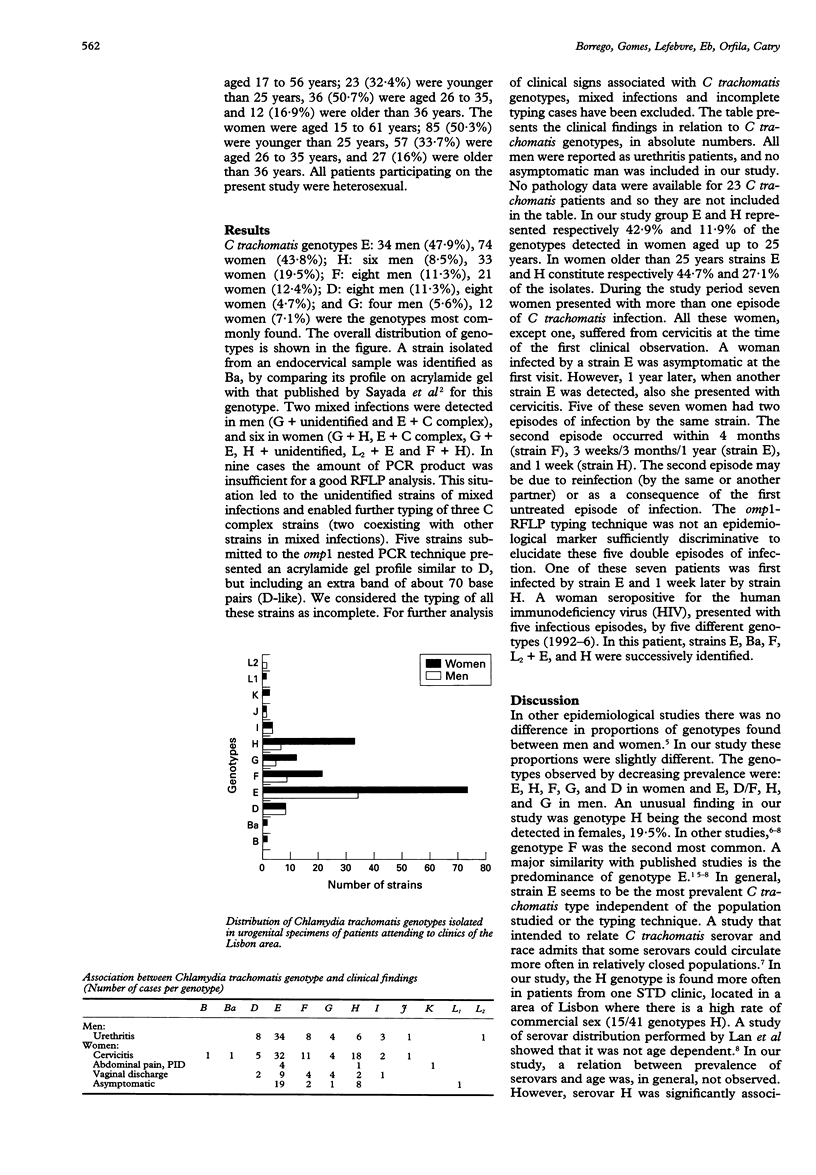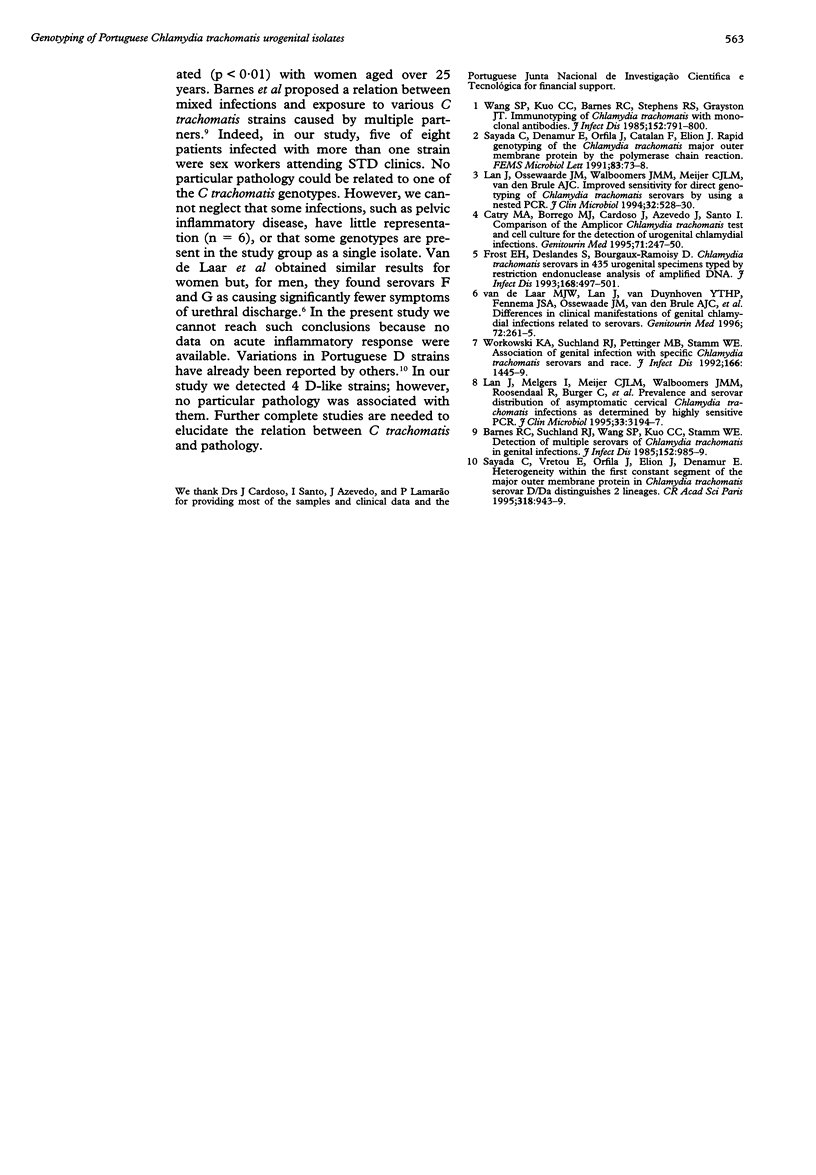Abstract
OBJECTIVE: To determine the prevalence of the different Chlamydia trachomatis genotypes in Portuguese patients. METHODS: Urogenital isolates (n = 240) derived from attenders of various clinics in the Lisbon area were differentiated into genovars by genotyping with restriction fragment length polymorphism (RFLP) analysis of the PCR amplified omp1 gene. RESULTS: Genotype E was the most common for both men (47.9%) and women (43.8%). Genotypes D and F were the second most prevalent for men (11.3%) and genotype H was the second most prevalent for women (19.5%). Genotypes F, G, D, in women and H, G, I, in men, were found in a lower percentage of cases. Genotypes B, Ba, J, K, L1 and L2 were very rarely detected. CONCLUSIONS: With one exception, the overall distribution of Chlamydia trachomatis genotypes in our study is similar to what has been observed in other western countries. The only exception is the unusual prevalence of genotype H among women. The clinical manifestations associated with this and other genotypes were similar.
Full text
PDF


Selected References
These references are in PubMed. This may not be the complete list of references from this article.
- Barnes R. C., Suchland R. J., Wang S. P., Kuo C. C., Stamm W. E. Detection of multiple serovars of Chlamydia trachomatis in genital infections. J Infect Dis. 1985 Nov;152(5):985–989. doi: 10.1093/infdis/152.5.985. [DOI] [PubMed] [Google Scholar]
- Catry M. A., Borrego M. J., Cardoso J., Azevedo J., Santo I. Comparison of the Amplicor Chlamydia trachomatis test and cell culture for the detection of urogenital chlamydial infections. Genitourin Med. 1995 Aug;71(4):247–250. doi: 10.1136/sti.71.4.247. [DOI] [PMC free article] [PubMed] [Google Scholar]
- Frost E. H., Deslandes S., Bourgaux-Ramoisy D. Chlamydia trachomatis serovars in 435 urogenital specimens typed by restriction endonuclease analysis of amplified DNA. J Infect Dis. 1993 Aug;168(2):497–501. doi: 10.1093/infdis/168.2.497. [DOI] [PubMed] [Google Scholar]
- Lan J., Melgers I., Meijer C. J., Walboomers J. M., Roosendaal R., Burger C., Bleker O. P., van den Brule A. J. Prevalence and serovar distribution of asymptomatic cervical Chlamydia trachomatis infections as determined by highly sensitive PCR. J Clin Microbiol. 1995 Dec;33(12):3194–3197. doi: 10.1128/jcm.33.12.3194-3197.1995. [DOI] [PMC free article] [PubMed] [Google Scholar]
- Lan J., Ossewaarde J. M., Walboomers J. M., Meijer C. J., van den Brule A. J. Improved PCR sensitivity for direct genotyping of Chlamydia trachomatis serovars by using a nested PCR. J Clin Microbiol. 1994 Feb;32(2):528–530. doi: 10.1128/jcm.32.2.528-530.1994. [DOI] [PMC free article] [PubMed] [Google Scholar]
- Sayada C., Denamur E., Orfila J., Catalan F., Elion J. Rapid genotyping of the Chlamydia trachomatis major outer membrane protein by the polymerase chain reaction. FEMS Microbiol Lett. 1991 Sep 15;67(1):73–78. doi: 10.1016/0378-1097(91)90447-i. [DOI] [PubMed] [Google Scholar]
- Sayada C., Vretou E., Orfila J., Elion J., Denamur E. Heterogeneity within the first constant segment of the major outer membrane protein gene in Chlamydia trachomatis serovar D/Da distinguishes 2 lineages. C R Acad Sci III. 1995 Sep;318(9):943–949. [PubMed] [Google Scholar]
- Wang S. P., Kuo C. C., Barnes R. C., Stephens R. S., Grayston J. T. Immunotyping of Chlamydia trachomatis with monoclonal antibodies. J Infect Dis. 1985 Oct;152(4):791–800. doi: 10.1093/infdis/152.4.791. [DOI] [PubMed] [Google Scholar]
- Workowski K. A., Suchland R. J., Pettinger M. B., Stamm W. E. Association of genital infection with specific Chlamydia trachomatis serovars and race. J Infect Dis. 1992 Dec;166(6):1445–1449. doi: 10.1093/infdis/166.6.1445. [DOI] [PubMed] [Google Scholar]
- van de Laar M. J., van Duynhoven Y. T., Fennema J. S., Ossewaarde J. M., van den Brule A. J., van Doornum G. J., Coutinho R. A., van den Hoek J. A. Differences in clinical manifestations of genital chlamydial infections related to serovars. Genitourin Med. 1996 Aug;72(4):261–265. [PMC free article] [PubMed] [Google Scholar]


